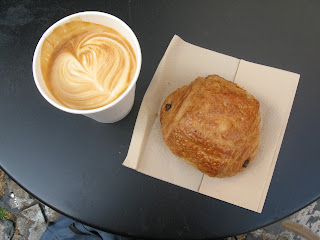(New readers: you can catch up here.)
But I haven't yet figured out why he had such a bone to pick with the Earl of Chesterfield: the man who sought to enter the club based on a display of wit rather than a delectable edible gift, thereby going against the club rules.
Who was Josiah Colebrooke, after all? An apothecary by trade, his long-standing membership in both the Society of Antiquaries and the Thursday's Club (he was the treasurer to both) suggests that he was dedicated to learning, self-improvement and the study of the past.
In 1776, shortly after his death, I found this document (to the left) advertising the auction of his most prized possession: his coin collection. Turns out that the guy had amassed a lot of them over the course of his life. The document runs seven pages long.
The records show that Colebrooke possessed a variety of Roman, Greek and Byzantine coins, but the great majority were of English origin. For a man of such dedication, I was surprised to find that most of them weren't terribly valuable; most cost between a pound or two: a respectable sum for the average guy, I suppose, but by no means a fortune.
I mean, Colebrooke was constantly asking his fellow Thursday's Club members to shell out a guinea (1 pound and 1 shilling) left and right to pay for all their "venison carriages" and bottles of claret. His beloved coin collection would have been a pittance to them.
(The priciest one, in case you were wondering, cost nearly seven pounds and is described as: "A very fine penny of Henry I, with the young face, very scarce.")
 |
| A penny of Henry I: Who knows if this was Colebrooke's most treasured coin? |
A couple ideas:
In Colebrooke's letter of protest over the admission of Chesterfield, he draws a distinction between principles of admission based on substantial forms, such as may be tasted, and ephemeral, immeasurable things such as wit and humour. Perhaps there's a parallel between Colebrooke's love of coins for their material uniqueness rather than their monetary value (otherwise, he wouldn't be collecting them!) and his privileging of ingestible foods over ineffable performances of "wit."
 |
| When venison was gifted to the club, it was served as a haunch, as a neck, and in pasty form. |
"a nobleman chosen a member of a dining club for communicating a petition to the king, will appear very abstruse ... posterity will be at a loss, to know whether this petition etc was not a name given to some new dish of that nobleman's invention"
Well, I'm not quite convinced that any 21st century reader would be fooled into thinking a "petition" was an Enlightenment delicacy. Regardless, does Colebrooke suspect that the perception of Chesterfield's apparent "wittiness" is informed by his noble birth? Maybe. For even if venison and turtle were known as elite foods, they actually seem to level the playing field within the confines of the club. After all, anyone –– nobleman or gentleman, the rules say –– may present them as gifts and reap the social rewards. And once served up on the table, everyone is entitled to appreciate them.
We often think of "taste" as marking distinctions between individuals rather than bringing people together. But for the petulant Mr. Colebrooke, it seems like the provision and sharing of food created for him a "common taste" that softened status distinctions within the society.







